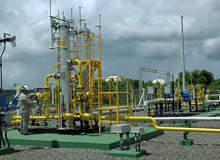
The 1,371km-long South-East to North-East Gas Pipeline or the Gasene Project is the longest ever pipeline built in Brazil.
It interconnects the south-east and north-east gas distribution systems in the country. It will transport natural gas produced at new fields in the Campos Basin to consumers in the north-east region of Brazil.
The project is owned and operated by Brazilian state oil company Petrobras. The pipeline was laid as part of the company’s Gas Production Anticipation Plan aimed at increasing natural gas supply to the south-eastern region of Brazil. The company invested $1.2bn in laying the pipeline. Construction was completed in March 2010 and the pipeline was commissioned in September 2010.
The Gasene pipeline has a diameter of 28in and a capacity of 20m m³/d. It begins from the Cabiúnas terminal in Rio de Janeiro and ends at Catu in Bahia. It will initially carry 10m m³/d of gas. The capacity will be ramped up to 20m m³/d by 2015, using compressor stations. The pipeline is expected to make Brazil self-sufficient in energy and reduce imports from Bolivia.
Design
The Gasene pipeline comprises three sections – Cacimbas-Vitória, Cabiúnas-Vitória (GASCAV) and Cacimbas-Catu (GASCAC).
The Cacimbas-Vitória section is 131km-long and the Cabiúnas-Vitória (GASCAV) section is 300km-long. The GASCAV section also includes a 10km branch line to Anchieta.
The 954km-long final section of the pipeline, Cacimbas-Catu (GASCAC), is the longest of the three sections.
The pipeline has eight delivery points along its route to supply natural gas to new markets. The first three are located at Itabuna, Eunapolis and Mucuri in Bahia. The other delivery points include Cachoeiro de Itapemirim, Anchieta, Viana and Vitoria, in Espirito Santo. The last delivery point is at Campos dos Goytacazes, in Rio de Janeiro.
Compressions stations are located at Piuma, Aracruz and Prado.
Construction
Construction of the Cacimbas-Vitória section commenced in mid-2005 and was completed in November 2007.
Work on the GASCAV section was started in 2006 and completed in 2007. This section was built in three phases. The first phase included a 78km segment from Cabiúnas terminal to Campos de Goytacazes in Rio de Janeiro. The 126km segment from Campos de Goytacazes and the Piúma compression station was constructed in the second phase.
The final phase of GASCAV included a 96km segment between the Piúma compression station and the pressure reduction station in Serra in Espiírito Santo.
Construction of the GASCAC section commenced in March 2008 and was divided into six. The parts were constructed simultaneously. The section included 151 river crossings and 88 unique crossing area projects and was completed in March 2010.
The GASCAC section included different types of terrain, resulting in several construction challenges. To overcome these problems special technologies were used during construction. In rocky terrains, rocks were blasted using explosives in a controlled and localised manner instead of the conventional ditch opening process.
The Pipe Sak technique was used to concrete the pipelines. This technique involved use of woven polypropylene bags filled with gravel. These bags are attached to the pipeline to stop buoyancy in floodplains.
A vacuum lifter was used for lifting pipes. The device uses vacuum suction to lift pipelines without ropes, wires or straps.
Pipeline route
The Cacimbas-Vitória section of the pipeline transports natural gas produced at the Peroá-Cangoá fields to Vitória in Espírito Santo. From Vitória, natural gas is carried to Cabiúnas, in Rio de Janeiro, by the GASCAV section of the pipeline.
The GASCAC section transports natural gas from Cacimbas to Catu in Bahia. It is also linked to the Catu-Carmópolis-Pilar pipeline.
Contractors
Petrobras awarded a $239m EPC contract to Sinopec in April 2006 for constructing the GASCAV section of the pipeline. Sinopec was also awarded the EPC contract for the GASCAC section in January 2008.
In 2007, TenarisConfab won a contract to provide pipes for the GASCAC section.
Siemens Energy won a contract in 2008 to supply 11 compressor trains for the three compression stations of the project. Siemens awarded a $10m contract to Rolls-Royce to supply 11 RF3BB-20 centrifugal gas compressors. The compressors are powered by 7.68MW Siemens SGT-200 gas turbines.
Socoril do Brasil, a unit of Socotherm, was awarded a $50m contract for providing anti-corrosion coatings for the pipeline. The company provided three-layer anti-corrosion coating of PLASTYKOTE and internal flow coating of INNERKOTE.

